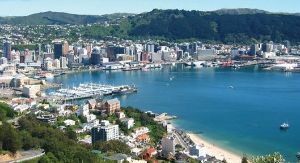The Capital leads in green real estate
Wellington is in the leading pack as one of the top five sustainably led cities for real estate in Asia Pacific.
Tuesday, October 25th 2022, 9:59AM
by Sally Lindsay

The capital, along with Singapore, Sydney, Perth and Melbourne make up the top five on global real estate company Frank Knight’s Asia Pacific (APAC) Sustainably Led Cities Index in its Rising Capital in Uncertain Times report.
The five cities benefit from a myriad of factors, such as reduction in per person carbon emissions, a large number of green spaces and low urbanisation pressures.
However, an unavoidable issue for all cities is climate risk, and some cities in Asia Pacific (APAC) will be more prone to them than others, especially cities located closer to the equator, says the report.
Already prolonged drought is taking the lives of many and heightening food insecurity. Sea level is also set to rise in tandem with the increase in global temperature.
While the real estate sector in APAC is adapting to these risks, Knight Frank says investors need to still brace themselves for how the impacts of climate risk and erratic weather changes will burden their investment portfolios.
There are three top factors contributing to the cities rankings.
Factor one – amount of green space available
To make urban environments healthier and more liveable, and as cities grow to include more people in an already crowded space, nature and green spaces are now more vital than ever.
While there is currently no universal definition of green space, the World Health Organisation (WHO) defined it as “spaces [that] may include places with ‘natural surfaces’ or ‘natural settings’, but may also include specific types of urban greenery, such as street trees, and may also include ‘blue space’ which represents water elements ranging from ponds to coastal zones”.
Common urban green spaces frequented by people are public parks and gardens. Other widely used definitions even include public green areas used predominantly for recreation such as gardens, zoos, parks, and suburban natural areas and forests.
Regardless of definition, multiple studies have shown green spaces bring about a spectrum of benefits for cities and their inhabitants, which range from mental to physical to social. Conversely, research has also shown an inadequate amount of green space in the environment is associated with feelings of loneliness and lack of social support. Green spaces are even more essential now as people were too cooped at home during Covid-19 quarantine, thus it acts as a good combat tool against the pandemic.
Factor two – green-rated commercial buildings
With 40% of carbon emissions emitted, 40% of the world’s energy being used and 30% of the world’s available drinking water being consumed from the built environment, it is only right the industry devises ways to mitigate the worsening climate and carbon situation.
To incentivise developers to invest in sustainability, most APAC government organisations have in place various green certifications to reward the building if it meets requirements, such as reduced potential environmental impact, lessened energy, water, and material resource consumption, amongst others.
There are also various reputable global certificates that developers can apply for their buildings. These awards serve as a differentiating factor to buildings in the real estate market, allowing businesses to cultivate a positive image and enhance returns on both the leasing rate and resale value of their buildings.
These awards are not mutually exclusive, and a green building can have multiple of such certificates, which further boost their green status and stand out from the pack.
Other than the awards, some government authorities have also set aside a budget to aid building owners in retrofitting and raising the sustainability level of their buildings to contribute to the city/country’s green goals within a certain period.
Frank Knight’s combining its proprietary data with green ratings and other geographical evidence for prime office buildings has found green-credited buildings command 8-18% sales price premium compared to non-green credited buildings, further motivating building owners to develop buildings that have sustainability features.
Factor three – urbanisation pressure
A United Nations study has projected that by 2050, two thirds of the world’s population will reside in cities or other urban areas. Half of the world’s urban population will be concentrated in Asia, with China and India having a combined share of 25%.
Cities generate more than 80% of the global Gross Domestic Product (GDP), rendering the phenomenon of urbanisation ever more pertinent. If managed well, urbanisation can lead to sustainable urban growth by enhancing productivity, encouraging innovation and current ideas to form.
However, the rate and scale of urbanisation bring about a range of social and environmental challenges and resource demands. Unforeseen challenges resulting from rapid growth include lack of affordable housing, well-connected and economical public transportation, and other essentials and amenities.
Hence, how well a city is planned and managed is vital since its land use pattern and physical infrastructure will stay status quo for generations to come. Its functionality will determine its ability to accommodate an urban sprawl.
Green financing
There has been a surge in green capital allocations in APAC in recent years as the action to achieve carbon neutrality gained momentum. More APAC economies have outlined plans to achieve net-zero emissions and invest in projects to cut down carbon intensity. These guidelines will highly likely give impetus to green financing beyond this year.
Green financing is any structured instrument (can be a product or service as well) used for investment into climate-related or environmental projects and is a vital tool in the net- zero journey. Such funds encourage the development of green projects and/or curtail the impact of carbon emissions by existing buildings. Green bond is one of the notable forms of green financing and is a rapidly growing sector in APAC.
Based on data from the Climate Bonds Initiative (CBI), a UK-based green debt tracker, the annual issue of green bonds took the market to $892.3 billion in 2021, a colossal surge of 71% from 2020. It is also the first time the market surpassed the half trillion mark, signifying the increasing prominence of green financing globally.
APAC had annual growth of 129%, making it a quarter of the market share and the fastest growing region for green bond sales.
| « Auckland rents at a standstill | New housing rules create dilemmas » |
Special Offers
Comments from our readers
No comments yet
Sign In to add your comment
| Printable version | Email to a friend |



